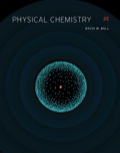
Interpretation:
An explanation as to how it would be determined whether
Concept Introduction:
A molecule having
The number of vibrations or degree of freedom of linear molecule is
Want to see the full answer?
Check out a sample textbook solution
Chapter 14 Solutions
Physical Chemistry
- It is possible to write a simple Lewis structure for the SO42- ion, involving only single bonds, which follows the octet rule. However, Linus Pauling and others have suggested an alternative structure, involving double bonds, in which the sulfur atom is surrounded by six electron pairs. (a) Draw the two Lewis structures. (b) What geometries are predicted for the two structures? (c) What is the hybridization of sulfur in each case? (d) What are the formal charges of the atoms in the two structures?arrow_forward(a) Methane (CH4) and the perchlorate ion (ClO4- ) are bothdescribed as tetrahedral. What does this indicate about theirbond angles? (b) The NH3 molecule is trigonal pyramidal, while BF3 is trigonal planar. Which of these molecules is flat?arrow_forwardWhat is the shape of the dichloromethane (CH2C12) molecule? Predict the Cl —C —Clbond angle.arrow_forward
- For a N H 4 + ion, identify its molecular shape, bond angle, and hybrid orbitals.arrow_forwardvalence of potassium tartrate, C4H4K2O6?arrow_forwardA student claims that if element D is in group 18, then the molecular geometry of DF4(g) is square planar. Do you agree or disagree with the student? Justify your answer in terms of the VSEPR theory.arrow_forward
- What atomic or hybrid orbitals make up the bond between C and O in carbon dioxide, CO2 ?arrow_forwardBoron trifluoride (BF3) has no dipole moment (u = 0 D). Explain how this observation confirms the geometry of BF3 predicted by VSEPR theory.arrow_forwardConstruct the molecular orbital diagram for SrCl. Would yo u expect the bond length of SrCl+ to be longer or shorter than that of SrCl? Explain and elaborate.arrow_forward
- Draw the molecular orbital diagram for C2 and O2. Indicate the bond order for each, and whether the molecules are paramagnetic or diamagnetic.arrow_forwardWrite the best Lewis dot structure for POCl₃, be sure to give the electronic geometry, molecular geometry, hybridization of the central element, polarity, and bond angle around the central element.arrow_forwardFor each of the following molecule: (i) draw the correct Lewis structure; (ii) determine the molecular geometry and the type of hybridization on the central atom, and (iii) predict whether the molecule is polar or nonpolar. (a) BrCl5arrow_forward
 Chemistry & Chemical ReactivityChemistryISBN:9781133949640Author:John C. Kotz, Paul M. Treichel, John Townsend, David TreichelPublisher:Cengage Learning
Chemistry & Chemical ReactivityChemistryISBN:9781133949640Author:John C. Kotz, Paul M. Treichel, John Townsend, David TreichelPublisher:Cengage Learning Chemistry: Principles and PracticeChemistryISBN:9780534420123Author:Daniel L. Reger, Scott R. Goode, David W. Ball, Edward MercerPublisher:Cengage Learning
Chemistry: Principles and PracticeChemistryISBN:9780534420123Author:Daniel L. Reger, Scott R. Goode, David W. Ball, Edward MercerPublisher:Cengage Learning
 ChemistryChemistryISBN:9781305957404Author:Steven S. Zumdahl, Susan A. Zumdahl, Donald J. DeCostePublisher:Cengage Learning
ChemistryChemistryISBN:9781305957404Author:Steven S. Zumdahl, Susan A. Zumdahl, Donald J. DeCostePublisher:Cengage Learning Chemistry: An Atoms First ApproachChemistryISBN:9781305079243Author:Steven S. Zumdahl, Susan A. ZumdahlPublisher:Cengage Learning
Chemistry: An Atoms First ApproachChemistryISBN:9781305079243Author:Steven S. Zumdahl, Susan A. ZumdahlPublisher:Cengage Learning Chemistry: The Molecular ScienceChemistryISBN:9781285199047Author:John W. Moore, Conrad L. StanitskiPublisher:Cengage Learning
Chemistry: The Molecular ScienceChemistryISBN:9781285199047Author:John W. Moore, Conrad L. StanitskiPublisher:Cengage Learning





